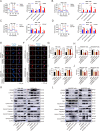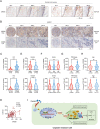A novel CREB5/TOP1MT axis confers cisplatin resistance through inhibiting mitochondrial apoptosis in head and neck squamous cell carcinoma
- PMID: 35773668
- PMCID: PMC9248137
- DOI: 10.1186/s12916-022-02409-x
A novel CREB5/TOP1MT axis confers cisplatin resistance through inhibiting mitochondrial apoptosis in head and neck squamous cell carcinoma
Abstract
Background: Cisplatin resistance is one of the main causes of treatment failure and death in head and neck squamous cell carcinoma (HNSCC). A more comprehensive understanding of the cisplatin resistance mechanism and the development of effective treatment strategies are urgent.
Methods: RNA sequencing, RT-PCR, and immunoblotting were used to identify differentially expressed genes associated with cisplatin resistance. Gain- and loss-of-function experiments were performed to detect the effect of CREB5 on cisplatin resistance and mitochondrial apoptosis in HNSCC. Chromatin immunoprecipitation (ChIP) assay, dual-luciferase reporter assay, and immunoblotting experiments were performed to explore the underlying mechanisms of CREB5.
Results: CREB5 was significantly upregulated in cisplatin-resistant HNSCC (CR-HNSCC) patients, which was correlated with poor prognosis. CREB5 overexpression strikingly facilitated the cisplatin resistance of HNSCC cells in vitro and in vivo, while CREB5 knockdown enhanced cisplatin sensitivity in CR-HNSCC cells. Interestingly, the activation of AKT signaling induced by cisplatin promoted nucleus translocation of CREB5 in CR-HNSCC cells. Furthermore, CREB5 transcriptionally activated TOP1MT expression depending on the canonical motif. Moreover, CREB5 silencing could trigger mitochondrial apoptosis and overcome cisplatin resistance in CR-HNSCC cells, which could be reversed by TOP1MT overexpression. Additionally, double-targeting of CREB5 and TOP1MT could combat cisplatin resistance of HNSCC in vivo.
Conclusions: Our findings reveal a novel CREB5/TOP1MT axis conferring cisplatin resistance in HNSCC, which provides a new basis to develop effective strategies for overcoming cisplatin resistance.
Keywords: CREB5; Cisplatin resistance; HNSCC; Mitochondrial apoptosis; TOP1MT.
© 2022. The Author(s).
Conflict of interest statement
The authors declare that they have no competing interests.
Figures







Similar articles
-
Nuclear TOP1MT Confers Cisplatin Resistance via Pseudogene in HNSCC.J Dent Res. 2024 Nov;103(12):1238-1248. doi: 10.1177/00220345241272017. Epub 2024 Oct 9. J Dent Res. 2024. PMID: 39382100
-
TNFAIP2 confers cisplatin resistance in head and neck squamous cell carcinoma via KEAP1/NRF2 signaling.J Exp Clin Cancer Res. 2023 Aug 1;42(1):190. doi: 10.1186/s13046-023-02775-1. J Exp Clin Cancer Res. 2023. PMID: 37525222 Free PMC article.
-
The Association of OLFM4 with the Progression and Cisplatin Resistance of Head and Neck Squamous Carcinoma.Curr Oncol. 2025 May 13;32(5):276. doi: 10.3390/curroncol32050276. Curr Oncol. 2025. PMID: 40422535 Free PMC article.
-
New advances into cisplatin resistance in head and neck squamous carcinoma: Mechanisms and therapeutic aspects.Biomed Pharmacother. 2023 Jul;163:114778. doi: 10.1016/j.biopha.2023.114778. Epub 2023 May 1. Biomed Pharmacother. 2023. PMID: 37137185 Review.
-
Mechanisms of Cisplatin Resistance in HPV Negative Head and Neck Squamous Cell Carcinomas.Cells. 2022 Feb 5;11(3):561. doi: 10.3390/cells11030561. Cells. 2022. PMID: 35159370 Free PMC article. Review.
Cited by
-
Nuclear TOP1MT Confers Cisplatin Resistance via Pseudogene in HNSCC.J Dent Res. 2024 Nov;103(12):1238-1248. doi: 10.1177/00220345241272017. Epub 2024 Oct 9. J Dent Res. 2024. PMID: 39382100
-
miR-32533 Reduces Cognitive Impairment and Amyloid-β Overload by Targeting CREB5-Mediated Signaling Pathways in Alzheimer's Disease.Adv Sci (Weinh). 2025 Mar;12(10):e2409986. doi: 10.1002/advs.202409986. Epub 2025 Jan 22. Adv Sci (Weinh). 2025. PMID: 39840513 Free PMC article.
-
Effect of regulatory cell death on the occurrence and development of head and neck squamous cell carcinoma.Biomark Res. 2023 Jan 5;11(1):2. doi: 10.1186/s40364-022-00433-w. Biomark Res. 2023. PMID: 36600313 Free PMC article. Review.
-
RFC2 promotes aerobic glycolysis and progression of colorectal cancer.BMC Gastroenterol. 2023 Oct 11;23(1):353. doi: 10.1186/s12876-023-02984-0. BMC Gastroenterol. 2023. PMID: 37821801 Free PMC article.
-
CREB5 Promotes the Proliferation of Neural Stem/Progenitor Cells in the Rat Subventricular Zone via the Regulation of NFIX Expression.Cells. 2025 Aug 12;14(16):1240. doi: 10.3390/cells14161240. Cells. 2025. PMID: 40862718 Free PMC article.
References
-
- Gibson MK, Li Y, Murphy B, Hussain MH, DeConti RC, Ensley J, Forastiere AA. Eastern Cooperative Oncology G: Randomized phase III evaluation of cisplatin plus fluorouracil versus cisplatin plus paclitaxel in advanced head and neck cancer (E1395): an intergroup trial of the Eastern Cooperative Oncology Group. J Clin Oncol. 2005;23(15):3562–3567. doi: 10.1200/JCO.2005.01.057. - DOI - PubMed
-
- Kelland LR, Mistry P, Abel G, Freidlos F, Loh SY, Roberts JJ, Harrap KR. Establishment and characterization of an in vitro model of acquired resistance to cisplatin in a human testicular nonseminomatous germ cell line. Cancer Res. 1992;52(7):1710–1716. - PubMed
Publication types
MeSH terms
Substances
LinkOut - more resources
Full Text Sources
Medical
Molecular Biology Databases
Research Materials

